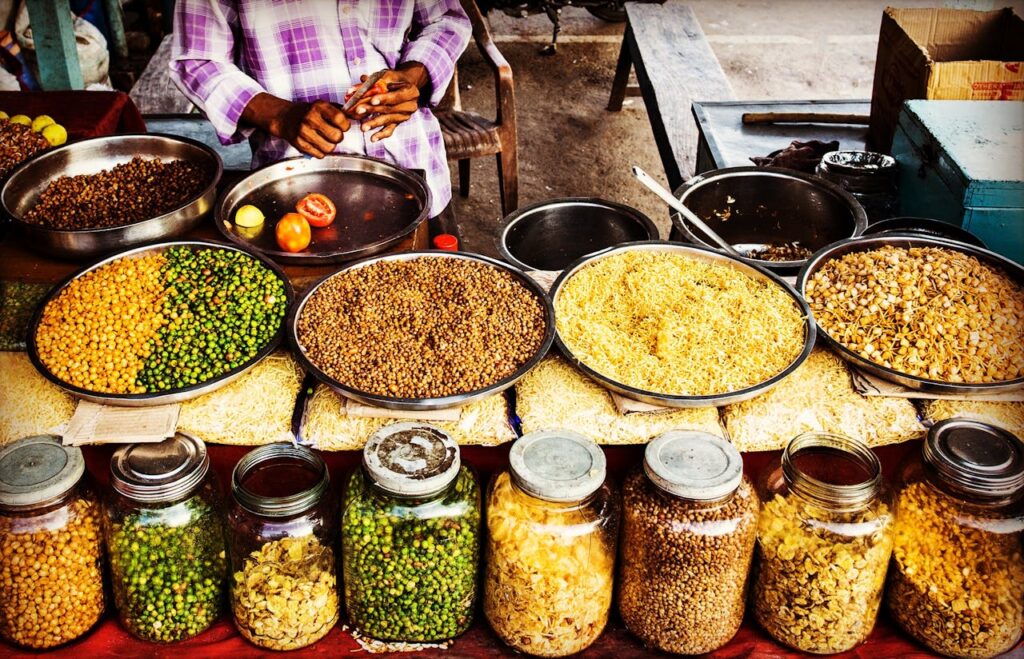
Explore & Play
Discover interesting topics and solve the accompanying crossword puzzle.
Spice Crossword | World of Spices
Table of Contents
Welcome to our comprehensive guide on spices! To enhance your experience, we invite you to start by tackling our engaging Spice crossword. This fun challenge will test your knowledge of various spices and set the stage for the detailed exploration that follows. If you’re not yet familiar with the world of spices, don’t worry—feel free to dive into the article first to build your understanding, and then return to the Spice crossword to see how much you’ve learned. Enjoy the journey through the aromatic world of spices!
Spice Crossword
You can either fill in the crossword puzzle directly on this page or click the button in the bottom right corner to print it for free.

The World of Spices: A Comprehensive Guide to Flavor Enhancers
Spices are the secret ingredients that elevate our meals from ordinary to extraordinary, adding depth, warmth, and complexity to every dish. They are the unsung heroes of the culinary world, transforming simple ingredients into memorable experiences. Understanding the vast array of spices and how to use them can unlock new dimensions of flavor in your cooking. Before diving into our exploration of spices, why not test your knowledge with a fun spice-themed crossword puzzle? It’s a great way to engage with the world of spices and see how many you recognize.
Section 1: The Basics of Spices
Understanding the basics of spices is the first step in mastering their use in your kitchen.
Spices are derived from various parts of plants, including seeds, bark, roots, and fruits. Unlike herbs, which come from the leafy parts of plants, spices offer a more intense flavor and aroma. Spices are typically dried and ground, although some are used whole. Proper storage is crucial; spices should be kept in airtight containers away from light and heat to preserve their potency. As you become more familiar with these fundamental aspects, you’ll be better equipped to experiment with and enjoy a wider range of spices.
Section 2: Common Spices and Their Uses
From the familiar scent of cinnamon to the bold kick of black pepper, common spices play a vital role in everyday cooking.
Pepper (Black and White):
Black and white pepper are staples in most kitchens. Black pepper is known for its sharp, pungent flavor, while white pepper is milder and used primarily in light-colored dishes. Both add a fundamental heat to recipes and enhance the overall flavor profile. Pepper is often ground fresh for maximum impact.
Cinnamon:
Cinnamon is a warm, sweet spice commonly used in both sweet and savory dishes. Its presence in apple pies, cinnamon rolls, and even curries highlights its versatility. This spice, derived from the bark of the cinnamon tree, can be used as a ground powder or in stick form. Cinnamon adds a comforting aroma and flavor to any dish.
Garlic:
Garlic is renowned for its bold, pungent flavor and is a cornerstone in many cuisines worldwide. It is used to enhance the taste of meats, vegetables, and sauces. Garlic can be used fresh, minced, or in powdered form, depending on the recipe and desired intensity.
Section 3: Exotic and Lesser-Known Spices
Exploring exotic and lesser-known spices can add a unique twist to your cooking and expand your culinary horizons.
Saffron:
Saffron is the world’s most expensive spice, derived from the stigmas of the crocus flower. Its vibrant yellow color and delicate flavor are prized in dishes like paella and risotto. Saffron not only adds visual appeal but also imparts a subtle, complex flavor that elevates dishes.
Cardamom:
Cardamom is an aromatic spice often used in Indian and Middle Eastern cooking. Its unique, slightly sweet flavor makes it a key ingredient in chai tea and various desserts. Cardamom can be used both as whole pods and ground powder, each providing a different intensity of flavor.
Sumac:
Sumac offers a tangy, lemony flavor that brightens up dishes. It is commonly used in Middle Eastern cuisine to add a zesty touch to salads and meats. Sumac is usually found in ground form and is a great addition to spice blends.
Za’atar:
Za’atar is a Middle Eastern spice blend that typically includes thyme, sesame seeds, and sumac. This aromatic mixture is often used as a seasoning for meats, vegetables, and flatbreads. Za’atar adds a savory, herbaceous quality to dishes.
Section 4: Herbs vs. Spices: A Detailed Comparison
While spices and herbs often work hand-in-hand, they each have unique characteristics and applications.
What Defines an Herb?:
Herbs like Basil and Parsley come from the leafy parts of plants and are used fresh or dried. Basil has a sweet, slightly peppery flavor, making it ideal for Italian dishes, while Parsley is versatile and used as a garnish or ingredient in a variety of recipes.
What Defines a Spice?:
Spices such as Nutmeg and Cloves come from different plant parts like seeds, fruits, or bark. Nutmeg offers a warm, sweet flavor often used in baking, while Cloves add a strong, aromatic quality to both sweet and savory dishes. Understanding these differences helps in selecting the right ingredients for your cooking.
When to Use Herbs vs. Spices:
Herbs are generally added toward the end of cooking to preserve their delicate flavors, while spices can be used at different stages to build depth in a dish. For instance, Rosemary and Thyme are often used fresh to flavor meats, while Cinnamon and Ginger are added early to infuse their flavors into soups and stews.
Section 5: Cooking with Spices: Tips and Techniques
Mastering the art of cooking with spices requires understanding their characteristics and knowing how to use them effectively.
How to Properly Store Spices:
To maintain the potency of your spices, store them in airtight containers in a cool, dark place. Cumin and Coriander are particularly sensitive to light and heat, which can diminish their flavor over time.
Best Practices for Using Spices in Cooking:
To release the full flavor of spices, consider toasting them lightly before use. Cumin and Mustard Seeds benefit from this technique, which enhances their natural oils and brings out a richer flavor.
Combining Spices to Create Flavor Profiles:
Creating complex flavors often involves blending multiple spices. For instance, a combination of Coriander, Cumin, and Turmeric can form the base of a delicious curry. Experimenting with different blends allows you to tailor dishes to your taste.
Common Mistakes to Avoid:
Avoid using too much spice, which can overpower a dish. It’s also important to balance spices with other flavors. For example, Paprika and Chili Powder add heat but should be complemented with other ingredients to create a harmonious taste.
Section 6: Health Benefits of Spices
Beyond their culinary uses, many spices offer significant health benefits and can contribute to a balanced diet.
Anti-Inflammatory Properties of Turmeric:
Turmeric contains curcumin, a compound known for its anti-inflammatory properties. Incorporating Turmeric into your diet can support overall health and wellness, particularly for its potential benefits in reducing inflammation.
Digestive Benefits of Ginger:
Ginger is well-known for its ability to aid digestion and soothe stomach issues. Adding Ginger to teas or dishes can help alleviate nausea and improve digestive health.
Antioxidant Richness of Cloves and Cinnamon:
Cloves and Cinnamon are rich in antioxidants, which help combat oxidative stress and support overall health. These spices not only enhance flavor but also contribute to a healthier diet.
Section 7: Global Spice Traditions
Different cultures have unique traditions and uses for spices, reflecting their history and culinary practices.
Indian Spice Traditions:
Indian cuisine is renowned for its complex spice blends and aromatic flavors. Spices like Cumin, Cardamom, and Fenugreek are integral to dishes like curries and biryanis, showcasing the rich spice heritage of India.
Middle Eastern Spice Blends:
Middle Eastern cooking features a diverse range of spices, with blends like Za’atar and Sumac playing a key role. These spices are used in dishes such as kebabs, salads, and stews, providing a unique and vibrant flavor profile.
Chinese Spice Characteristics:
Chinese cuisine often incorporates spices like Szechuan Pepper and Star Anise to create distinctive flavors. Szechuan Pepper adds a numbing heat, while Star Anise contributes a sweet, licorice-like flavor to various dishes.
Section 8: DIY Spice Blends and Recipes
Creating your own spice blends allows you to tailor flavors to your preference and bring a personal touch to your cooking.
Recipe for Homemade Garam Masala:
Garam Masala is a popular spice blend in Indian cuisine. To make your own, combine Coriander, Cumin, Cloves, and Nutmeg in a spice grinder for a fragrant and flavorful mix.
How to Make a Custom Curry Powder:
Craft your own curry powder by mixing Turmeric, Ginger, Mustard Seeds, and Paprika. Adjust the proportions based on your taste preferences to create a blend that perfectly complements your dishes.
Creating Your Own Herbal Blends:
Mix dried Oregano, Thyme, and Rosemary to make a versatile herbal blend. This combination is excellent for seasoning meats, vegetables, and soups, adding a fresh, savory touch to your meals.
Exploring Spices: A Flavor Adventure Awaits
Spices are more than just flavor enhancers; they are a gateway to discovering new cuisines and enjoying a richer culinary experience. By experimenting with different spices and blends, you can transform your cooking and delight in the diverse world of flavors.
Ready to test your spice knowledge further? Dive into the spice-themed crossword puzzle and see how many of these aromatic ingredients you can identify! It’s a fun way to reinforce your learning and challenge yourself.
Share to...
I hope you enjoy the content.
Want to receive our daily crossword puzzle or article? Subscribe!
You may also be interested in
Share to…
Want to receive our daily crossword puzzle?
-
Jigsaw Puzzles
Fjord Elegance: Abstract Jigsaw Puzzle 250 | 300 | 500 Pieces
kr 348,00 – kr 439,00Price range: kr 348,00 through kr 439,00 Select options This product has multiple variants. The options may be chosen on the product page -
Jigsaw Puzzles
Autumn Whiskers and Pumpkin Paws Puzzle 250 | 300 | 500 Pieces
kr 348,00 – kr 439,00Price range: kr 348,00 through kr 439,00 Select options This product has multiple variants. The options may be chosen on the product page -
Jigsaw Puzzles
Enchanting Unicorn Watercolor Jigsaw Puzzle 250 | 300 | 500 Brikker
kr 348,00 – kr 439,00Price range: kr 348,00 through kr 439,00 Select options This product has multiple variants. The options may be chosen on the product page

















